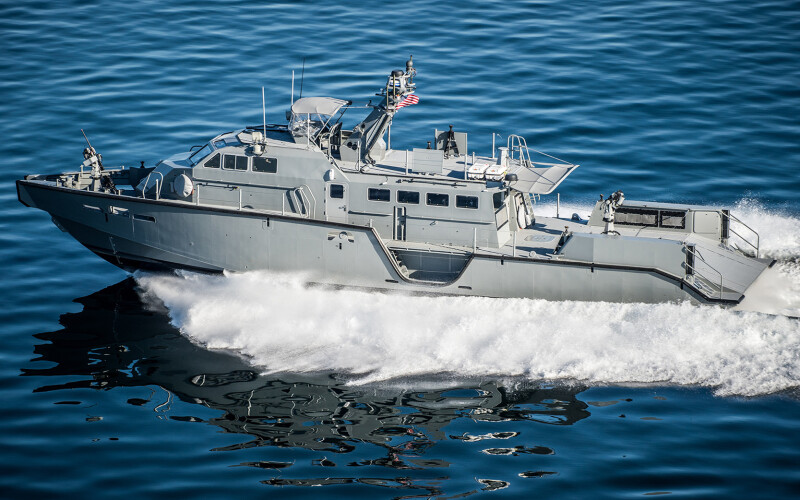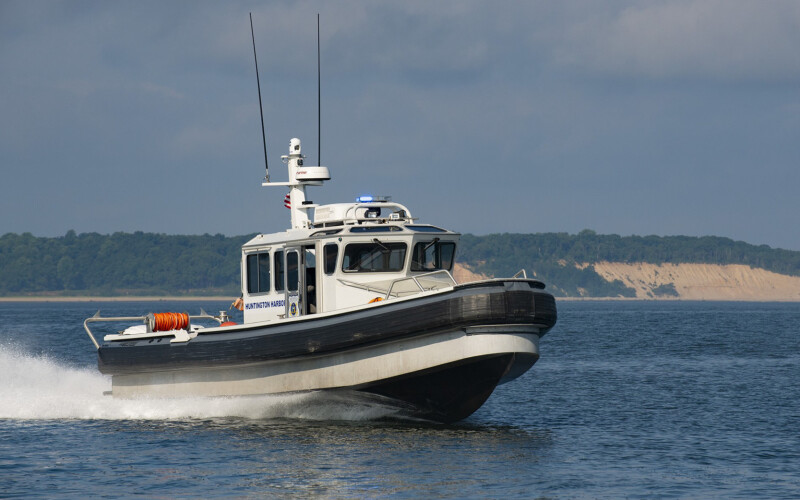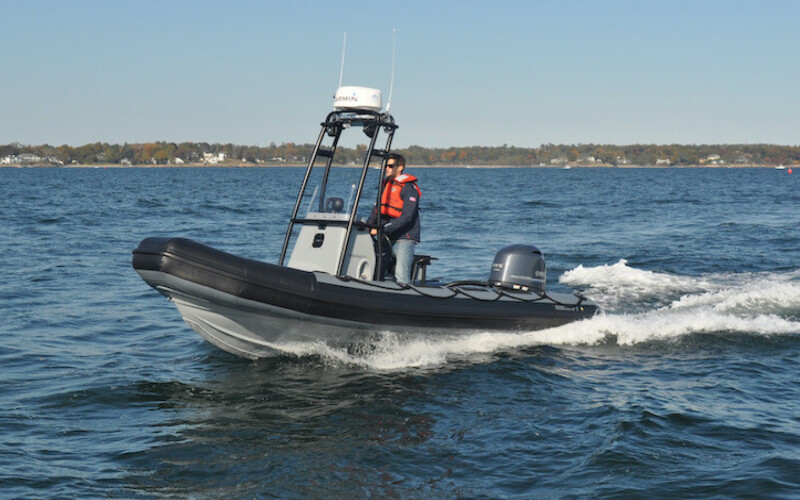It’s hard to go a day without hearing about a multiple shooting somewhere in the U.S. Though most of these nightmares occur on land, they could just as easily happen aboard a crowded commuter ferry or other passenger vessel.
What about protecting a state’s natural resources against those who try to destroy them?
And what about protecting U.S. interests at home and overseas? The Navy and Coast Guard work their patrol boats hard and for long periods of time.
“There is certainly more competition in the homeland security space than there used to be. Over the past year [from June 2022 through mid-July 2023] we have delivered over 40 vessels whose primary function is maritime patrol and/or law enforcement,” said Troy Knivila-Ritchie, marketing and sales specialist for Safe Boats International, Bremerton, Wash. “Customers range from state and local jurisdictions, federal [Customs and Border Protection, the Coast Guard and the Department of Defense] and several international customers via foreign military sales [FMS] throughout South and Central America, Africa, and the Caribbean. Additionally, many more customers are in the pipeline to receive patrol/marine law enforcement vessels in the coming year.”

SAFE BOATS
In late 2021, Safe Boats was awarded an $89.7 million contract modification to a previously awarded contract for design, construction, outfitting, reactivation, and training for six Mk VI patrol boats with an option for two additional vessels.
The contract will provide Mk VIs to Ukraine by way of a U.S. State Department-approved agreement utilizing building partner capacity (BPC) and foreign military financing (FMF) funds. Work is being performed in Washington state, and Safe Boats expects to increase its workforce by creating up to 75 new positions, primarily at its Tacoma, Wash., facility. Final delivery on the contract is slated for March 2025 (or March 2026 if the option is exercised).
Propelled by HamiltonJet waterjets and twin, 2,600-hp, MTU 16V 2000 series diesel engines (5,200-hp total), the 85' Mk VI has a range of more than 600 nm, a cruising speed of over 25 knots (with a sprint speed of 35-plus knots), and a draft of 4.5', “making it ideal for littoral operations,” said Knivila-Ritchie.
Safe Boats was on the leading edge of supplying vessels to the homeland security initiative post-9/11, Knivila-Ritchie said. Deliveries included:
- Hundreds of 25' full-cabin response boats-small;
- Multiple 33' full-cabin special purpose craft-law enforcement vessels;
- Numerous cutter-launched, 26' inboard over-the-horizon vessels (very often deployed in drug and migrant interdiction as well as search and rescue operations; and more than 50 41' T-top coastal interceptors for the Customs and Border Protection.
Knivila-Ritchie said that over the next five years, patrols will require operators to be on station for longer periods of time. “We have already seen the need for and have installed more comfortable seating and gyroscopic motion controls to help ease that burden,” he said. “If the market leans towards autonomous patrols, we will rise to the opportunity.”
In fact, Safe Boats has collaborated with Mythos AI to build hydrographic survey vessels with autonomous capability. Their autonomy/perception suite and hydrographic tools were integrated into the Porter 78S (261 outboard-driven, full cabin vessel), whose size and layout suited their requirements. The boats (two have been delivered so far) were built at Safe Boats’ Bremerton production facility based on a design from one of its global partners, Stormer Marine, out of the Netherlands.
“More orders are planned for the Porter 78S over the next year as customers adopt the platform,” Knivila-Ritchie said. “The current deployment of the technology Safe Boats is involved in is geared towards hydrography and survey work, but the autonomous technology certainly has applications in other fields, including marine patrol.
“The use of autonomous technology on the water is still developing and we hope to play a significant role in growing the capability and adoption of autonomous-capable vessels for patrol operations and beyond.”

NORTH RIVER BOATS
Roseburg, Ore.-based North River Boats, which mainly works off referrals, has been building heavy-gauge aluminum patrol boats and law enforcement vessels for decades.
The shipyard has dedicated project managers (PCs) for every commercial boat that is built. The PC sees the boat through the entire build process from concept to delivery and reactivation.
Mike Blocher, the company’s director of sales, said the shipyard has a diverse customer base.
“Washington Department of Fish and Wildlife and California Department of Fish and Wildlife have continued to use our product regularly for all of their patrol boat needs,” he said. “Additionally, we are building patrol boats for tribal groups, sheriffs’ departments, and many other agencies.”
North River’s design department uses 3D Rhino design software that allows for precise router-cut parts to ensure a proper fit. The design team is in-house and has extensive experience in the marine industry. The shipyard retains a dedicated professional engineering firm for the necessary engineering calculations and approvals during the design and build process.
“During the past few years, you have seen an increase in manufacturing across all market segments, including patrol boats,” Blocher said. “This is one reason that North River Boats invests in diversification so that we are vested in many market segments and are not reliant on specific markets.
“As one market segment increases, others will decrease. Being able to respond to these increases or decreases effectively allows North River the flexibility to bid on projects that fit well into our production and growth plan.”
Blocher said company officials are very mindful of what autonomous vessels can do for their customers and are very in tune with their wishes. “North River Boats continues to research and monitor the autonomous vessel market. How much effect this has on the patrol boat industry remains to be seen. We have been seeing more advancements in other field areas, such as hydrographic survey,” he said.
As for the future, Blocher said the trend seems to favor larger and more complex patrol boats with multimission capabilities. “We see this continuing over the next few years,” he said. “Government and commercial sales remain strong currently. World and national economics must be watched carefully, but right now I don’t see a downturn any time soon in this market.”

MARKET WATCH
Here are some other patrol boat newbuilds that are either under contract or under construction.
- MetalCraft Marine, Watertown, N.Y., was recently awarded a second contract by the Coast Guard for the new Long Range Interceptor III Program. Long range means 200 nm. The 35'×11'1'×4'8" LRI IIIs will have twin Cummins 6.7L diesels, producing 473 hp each, that power two Kongsberg A29 waterjets through ZF 280 marine gears. The power package will give the LRI IIIs a 40-knot top speed and will be mission capable to sea state 5 (13') conditions. The boats will have a closed or open cabin arrangement.
- All American Marine Inc., Bellingham, Wash., is working on a contract from the California Department of Fish and Wildlife (CDFW) for a 74'×27.5' catamaran patrol vessel. The aluminum vessel will patrol state and international waters for the CDFW. The twin engine, fixed-propeller vessel will be built to Coast Guard standards. The hydrofoil-assisted vessel from Teknicraft Design, Auckland, New Zealand, will combine design features critical to modern maritime law enforcement and is based on the All American-built Captain Murchison delivered to the Texas Parks and Wildlife Department.
- The CDFW also took delivery of three more 19'4"×8' Ribcraft 5.85 RIBs this past year. With these additional boats, all of the department’s long-range fisheries patrol boats now operate with a new Ribcraft 5.85 onboard. The RIBs, which draw 14" (without engine), are deployed for boarding and enforcement up to 200 miles offshore. The delivery of these 19' RIBs completes the fleet with four others already in service.
- Eastern Shipbuilding Group is currently building the Coast Guard cutter Rush (WMSM-918) — Hull 4 of the Heritage-class offshore patrol cutter (OPC) program. Eastern’s design of the 360'×54' cutter calls for a draft of 17', speed in excess of 22 knots, a range of 10,200 nm (at 14 knots), endurance for 60-day patrol cycles, MH-60R or MH-65 helicopter capability, and three over-the-horizon (OTH) cutter boats. The OPC will conduct missions including law enforcement, drug-and-migrant interdiction search and rescue, and other homeland security and defense operations.




.jpeg.medium-cropped.800x500.jpg)